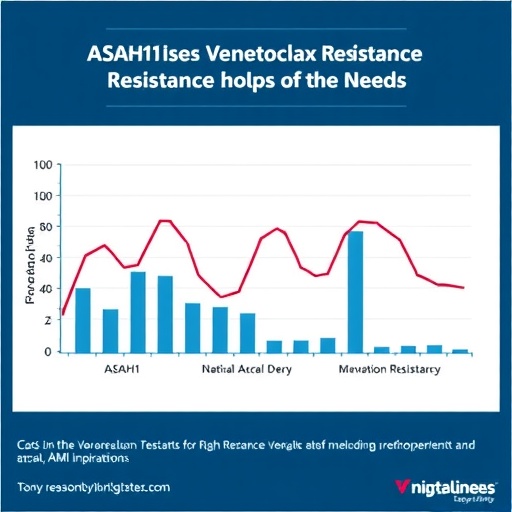In a groundbreaking study published in BMC Cancer in 2025, researchers have unveiled a critical mechanism underlying resistance to venetoclax (VEN) in acute myeloid leukemia (AML), particularly focusing on the enigmatic monocytic phenotypes. This research delves deeply into the complex landscape of sphingolipid metabolism as a driver of therapeutic resistance, offering new avenues for overcoming one of the most pressing challenges in AML treatment.
Venetoclax, a BCL-2 inhibitor, combined with hypomethylating agents, has revolutionized the therapeutic approach for elderly AML patients who are ineligible for intensive chemotherapy. Despite the initial promise, resistance to VEN remains a formidable barrier, especially in AML subtypes characterized by monocytic differentiation. These monocytic leukemias demonstrate a distinct clinical behavior and poor response rates, prompting urgent investigation into the underlying biological processes.
Leveraging an integrative multi-omics strategy, scientists from the study harnessed bulk RNA sequencing, single-cell RNA sequencing (scRNA-seq) of patient bone marrow samples, patient-derived xenograft (PDX) models, and lipidomic profiling of VEN-resistant cell lines to dissect the metabolic rewiring associated with resistance. This comprehensive approach enabled an unprecedented exploration of the cell-intrinsic alterations that facilitate survival under VEN pressure.
A pivotal discovery from the bulk RNA-seq data was the pronounced upregulation of sphingolipid metabolism-associated genes within the French-American-British (FAB) M5 subtype, a monocytic AML classification notoriously less responsive to VEN-based therapies. Sphingolipids, known bioactive lipids, play vital roles in cell fate determination, apoptosis, and signaling pathways, implicating their metabolic flux as a key factor in resistance mechanisms.
The single-cell transcriptome analysis further refined this observation, revealing that monocytic AML cells persisting post-VEN treatment exhibited the highest enrichment in sphingolipid metabolic signatures. Notably, cells co-expressing CD14 and ITGAX surfaced as a resilient population, indicating their potential role as mediators of VEN resistance. This cellular subpopulation might represent the leukemia subset that evades therapeutic eradication through metabolic adaptation.
Delving deeper, the investigation of VEN-resistant AML cell lines painted a complex picture of metabolic remodeling. These cells not only showcased elevated monocytic markers but also distinct lipidomic changes, underscoring the rewiring of sphingolipid metabolism as a dynamic adaptive response. Among the crucial regulators identified, ASAH1, the gene encoding acid ceramidase—an enzyme pivotal in ceramide catabolism—was significantly upregulated in resistant cells, whereas SPHK1, another metabolic enzyme, showed downregulation.
ASAH1’s role in modulating ceramide levels is particularly intriguing given ceramide’s pro-apoptotic properties. By enhancing ceramide degradation, increased ASAH1 activity may diminish apoptotic signaling, thereby promoting leukemic cell survival amidst VEN treatment. This insight offers a mechanistic rationale for targeting ASAH1 as a potential strategy to restore drug sensitivity.
The functional validation of ASAH1’s involvement was elegantly demonstrated through knockdown experiments. Reducing ASAH1 expression sensitized resistant AML cells to VEN without compromising the expression of the monocytic markers CD14 and CD64. This indicates that therapeutically targeting ASAH1 disrupts the metabolic shield without altering the cell’s differentiation state, highlighting an exploitable vulnerability within the resistant leukemic niche.
These findings collectively posit that sphingolipid metabolic reprogramming, particularly via ASAH1 modulation, plays a critical role in the emergence and maintenance of VEN resistance in AML beyond mere monocytic differentiation. This metabolic adaptation allows leukemic cells to subvert apoptosis, facilitating treatment evasion and disease persistence.
Understanding the metabolic underpinnings of drug resistance in AML provides a fertile ground for the development of novel combination therapies. Targeting sphingolipid metabolism alongside VEN could potentially overcome resistance, enhance remission durability, and improve patient outcomes. Such metabolic interventions might include ASAH1 inhibitors or modulators of downstream pathways involved in ceramide metabolism.
Moreover, the identification of specific monocytic cell subsets resilient to VEN therapy opens new possibilities in precision medicine. By characterizing these populations at the single-cell level, treatments can be tailored to target resistant clones more effectively, minimizing relapse risks and extending survival.
The study also emphasizes the significance of integrating high-resolution single-cell techniques with metabolic profiling to unravel the complexity of leukemia biology. This integrative methodology sets a precedent for future investigations into therapy resistance mechanisms not only in AML but in various cancers exhibiting metabolic plasticity.
While further preclinical and clinical validations are necessary, these findings mark a substantial leap toward understanding and combating VEN resistance. They underscore the critical need to look beyond phenotypic classifications and consider metabolic circuitries as key determinants of therapeutic response.
Given the pervasive nature of metabolic adaptation in cancer, these insights could resonate broadly across oncology, inspiring novel strategies that exploit metabolic vulnerabilities to reverse drug resistance. The targeted modulation of sphingolipid pathways may emerge as a universal paradigm in the fight against treatment-refractory malignancies.
In conclusion, the research illuminates the central role of ASAH1-mediated sphingolipid metabolism in shaping venetoclax resistance in AML. By peeling back layers of cellular heterogeneity and metabolic flexibility, this study not only expands the conceptual framework around monocytic AML phenotypes but also charts a strategic path toward more effective, metabolism-informed therapeutic regimens.
Subject of Research: Venetoclax resistance mechanisms in acute myeloid leukemia (AML), focusing on sphingolipid metabolic reprogramming mediated by ASAH1 in monocytic AML phenotypes.
Article Title: ASAH1-mediated sphingolipid metabolic reprogramming in venetoclax resistance of AML: beyond the monocytic phenotypes
Article References:
Zhao, L., Xiang, X., Zhong, A. et al. ASAH1-mediated sphingolipid metabolic reprogramming in venetoclax resistance of AML: beyond the monocytic phenotypes. BMC Cancer (2025). https://doi.org/10.1186/s12885-025-15272-9
Image Credits: Scienmag.com




